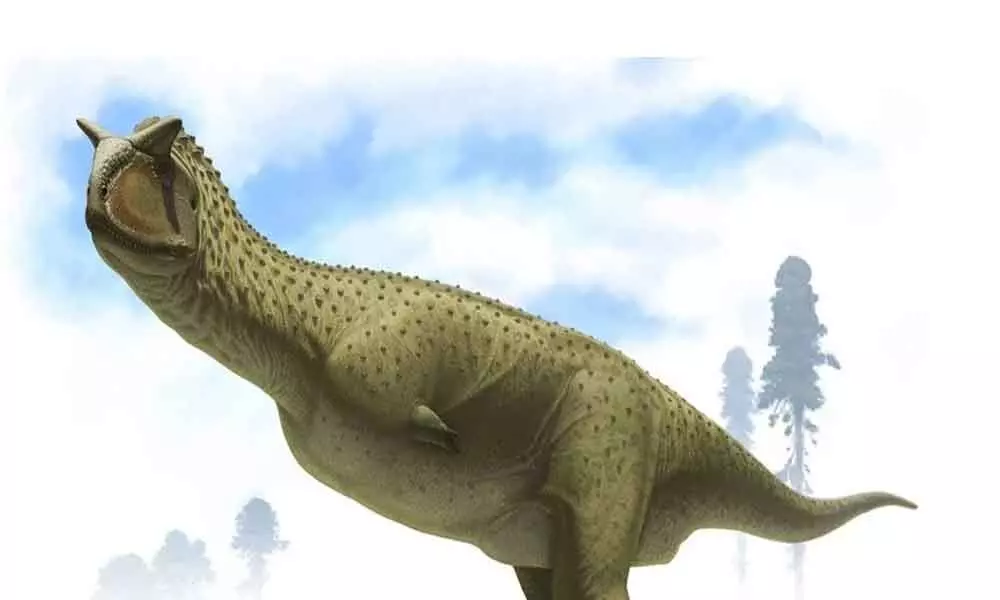Live
- Kancha Gachibowli land: Activists launch campaign to preserve urban lung space
- GHMC proposes euthanasia for aggressive strays
- Over 6 lakh Olive Ridleys turn up at Gahirmatha
- Two women journos held for ‘defaming’ CM
- 25 lakh ‘Lakhpati Didis’ in next 5 years: Patra
- Villagers come together against illegal mining
- NALCO holds Customers’ Meet
- Notorious criminal injured in encounter
- Food safety officials inspect mangoes at Mozamjahi mkt
- Oppn seeks withdrawal of Bahinipati’s suspension
Species Of Armless Dinosour Found In Argentina

Hans News Service | 21 Feb 2022 3:15 PM IST

x
Species Of Armless Dinosour Found In Argentina
Highlights
- The dinosaur, called Guemesia ochoai and discovered from a single skull, is likely to be a member of the abelisaurid lineage of tiny-armed carnivores
- The arms of the recently found species would have dropped ineffectually onto its large chest if they were anything like those of its Patagonian ancestors.
Paleontologists in Argentina have discovered a new dinosaur species with forearms that were so weak that it would make the Tyrannosaurus rex appear like Popeye.
The dinosaur, called Guemesia ochoai and discovered from a single skull, is likely to be a member of the abelisaurid lineage of tiny-armed carnivores that previously roamed Europe, Africa, South America, and India before going extinct approximately 66 million years ago.
G. ochoai's skull is the very first thing of its kind found in northwest Argentina, and it dates back about 70 million years. Its braincase is'remarkably tiny' in comparison to other abelisaurids.
In addition, it's one of the smallest-brained abelisaurids ever discovered, at 70 percent the size of the famed Carnotaurus genus from South America's southern tip.
The arms of the recently found species would have dropped ineffectually onto its large chest if they were anything like those of its Patagonian ancestors. Abelisaurids couldn't flex their upper appendages or grab anything in within their fingers without ossified wrist bones or movable elbow joints. They didn't have claws at all.Despite the fact that the T. rex in the Northern Hemisphere had longer and more muscular arms, abelisaurids were still capable of taking down prey much larger than themselves. Their powerful jaws and blade-like teeth more than compensated for their short forelimbs.
G. ochoai said that having only a skull to rely on, it's difficult to how compared to other abelisaurids, but a news statement from the Natural History Museum of the United Kingdom connects it to Carnotaurus sastrei, which has a smaller head and no horns.
The findings back up other recent findings that imply abelisaurid diversity in South America was greater than previously imagined. It appears that abelisaurids were able to adapt to distinct isolated environments as the southern supercontinent, Gondwana, began to split off.
It's still a mystery why they developed such small arms. Experts believe these are vestigial limbs, leftovers from ancestors who profited from their presence in the past.Almost majority of the abelisaurid fossils discovered in Argentina so far come from Patagonia, and they share numerous morphological characteristics, including absurdly short arms.
Meanwhile, if it can be considered that the dinosaur's head, for example, has a series of microscopic pores that may have allowed it to cool down by pushing blood to the skin's surface and dispersing heat. Besides south, such a characteristic would be less valuable.

Next Story
More Stories
© 2025 Hyderabad Media House Limited/The Hans India. All rights reserved. Powered by hocalwire.com






